________________
210
THE INDIAN ANTIQUARY.
[AUGUST, 1883.
saré Ašvayukt-ámávásydrian Somaváré vyatípáta- ydge.
It was also used sometimes by the Hoy. Balas; e.g.-27, the Gadag inscription of Bal. lá la II.," (11. 43-4) Saka-nripa-kál-útita-saivatsara-satéshu chaturddas-adhikéshumeládaśasu ankato=pi 1114 varttamána-Paridhávi-saivatsarástarggata - Marggasirsha - paurņņamásy dah Sanaischara-páré soma-grahané; and-28, another Gadag inscription of the same king, (11. 32-4) Saka-nripa-kál-atata-samvatsara-satagalu 1197 neya Siddhartthi-sahvatsarada Pratham-Ashada (dha)-suddhapaksh-áshtami-Brihaspativára-bya (vya) tipdta-punya-dinado!.
And it was used occasionally by the Yå davas of Dêvagiri; e.g.-29, 8 Gadag inscription of Singhaņa II.," (11. 34-6) Saka-nripa-kal-akrdintasashvatsara-latangaļu 1135neya (for 1134) Ángirasa-sanvatsarada Phálguna(na) budhdha- (ddha) bidige Sanaiécharavárad-aidu.
Almost identical with the preceding is the expression
Saka-bhúpála-kala or the time of the saka king,' which is furnished by— 30, a Hatti-Mattûr inscription of the Rashtrakata king Indra IV., (11. 3-5) Sasa)ka - bhsúpála-kal-a(a)keránta-san[va"]tsara- Praba( bha )v-ádi - ndmadé (dhé)yamvuttamamadhyama-jaghanya-pa(pha).add(da)-prabhsitigaļ=entu nura muvatt-ente(na) neya Dhátu-sanvatsar-a(Q)ntarggata. The same expression occurs also in- 31, a Gadag inscripion of the Western Chalukya king Satyaśraya II., (11. 7-8) Safía)ka-bhúpála-kd!-dlerdinta-savivatsara-sa(ka)tarnga[!] 024neya Subhaksit-sashvatsaranh pravarttise tad-varsh-ábhyantara Chaitra buddha 6 Adityavárad-andu; and in 32, the Pâtņå inscription of Gôvana III. of the Nikumbha family," (11. 20-1) Varshánária pancha-saptatyk sahasré sádhike gate 7075 Saka-bhúpála-kálasya tatha Srimukha-vatsaré. .
In the same category with the preceding two expressions we may classify that of
Saka-nripati-saivatsara or the years of the Saka king,' which is supplied by--33, the Haidarâbâd grant of the Western Chalukya king Palikesi 11.," (11. 12-13) Saka-npipati-saavatsara-batéshu chatus
trinns-adhikéshu panchasv=atítéshu Bhadrapad. ámávásy dyan súryya-grahaņa-nimittaris.
And in the same category we may classify the almost identical expression
Saka-nsipa-sasivatsara or the years of the Saka king, which is furnished by-34, the Kadab grant of the Rashtra kuta king Gôvinda III.," in which the date is expressed (11. 83-4) by Saka-ntipa-smisdatearéshu Sara-sikhi-munishu vyatitéshu JEGjyat)shthamüsa-bukla-paksha-dasamyánh Pushya-nakshatra Chandraváre. The same expression is used in
-35, a Balagâmve inscription of the Hoysaļa king Ballála II.," (11. 34-6) 8a(sa)ka-nripasarivachchha(tsa)ra(rá)m(d)-árabhya s atadhika-sahasr-/pari-saptadacha(sa)mé (for 1116) A[na]nda-sanvachhcha(tsa)ró Márggasirshamávásybyári Somaráré vyatépáta-yogé.
The next technical expression for this era, vis.
Saka-nsipati-rajyábhishế ka-småpatsara or the years of the inauguration in the sovereignty of the Saka king,'* is supplied by-36, the BAdámi inscription of the Early Chalukya king Mangallávara," in which the date is given (11. 6-7 and 11) by Saka-npipati-rdjyábhishekasahova(na) tsari shumatikkrá(krd)ntéshu panchasu éatéshu...... mahd-Kárttika-paurnnamdoyGrin. This inscription furnishes the important information that the starting point of the era was, not the birth, but the coronation of the king or kings whose name, or whose dynastic name, it bears. I have not as yet found any instance of this expression being repeated, or of any other expression so particularly explicit being used. The next technical expression, via.
Saka-kala + or 'the time of Saka of the sakas,' is supplied by-37, the Goa grant of the Early Chalukya king Mangaliśvara's son or feudatory, Satyábraya-Dhruvaraja-Indravarmi," in which the date is given (11. 6 and 18-19) by Mágha-pauranamásyam ...... Saka-kdlah-pancha varsha-satáni dod-tri(tri) nádni.
And the same expression was used occa sionally by the Rashtrakūtas; e.g.38, the Sâmångad grant of Dantidurga, " (1. 30-1)
4 Ind. Ant. Vol. II. PP 299 1. » P. 8. and 0.-C. Inscriptione, No. 99. 91 id. No. 100. » Ind. Ant. Vol. VIII. pp. 39. » id. Vol. VI. pp. 72 ff
30 d. Vol. XII. pp. 118.
P.S. and 0.-C. Inscriptions, No. 194. ** Or 'king." » Ind. Ant. Vol. VI. pp. 3631; And Vol. X. pp. 57. ** Jour. Bo. Br. R. As. Soc. Vol. X. pp. 348 1. » Ind. Ant. Vol. XI. pp. 1068.




